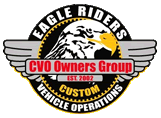A lot of you guys know I had the Zipper's 575 gear-driven cams installed by Bumpus H-D in Memphis, TN last fall. The bike ran great in Maggie Valley while we were there for the CVO event, but Unbalanced noticed some smoking from the rear cylinder (Rinehart true duals) from time to time. Then, throughout the trip to the AMA Superbike races in Birmingham, AL this past April, the bike was feeling like it was "missing" in the 2,000 - 3,000 rpm range under a light or steady throttle, and I experienced a lot of popping under decel, until the bike was good and hot (50+ miles into a ride). As if that was not enough, more people there (JR, TCnBham, 07hd110 and others) witnessed more smoking coming from the left pipe from time to time, and while sitting in line to do the parade lap, I was finally able to see it myself.
To make a long story short, I did not ride the bike much since returning from B'ham because we ended up relocating for my job, but every time I got on the bike I was getting more and more annoyed with the poor driveability of the hesitation/miss and the (sometimes very loud) popping on decel. So, once we got settled in the new location here, I decided to try to have something done about it and ended up taking it to the local dealer here, Andrae's H-D in Champaign, IL, after some help from JR and Brian Rose, the tech at Bumpus who did the original tune, who did a little bit of "scouting" work for me about the talent there (another long story).
So, to try to get to the point here . . . after all of this my bike has been on 3 different dynos. It was on 2 different dynos with SE air cleaner, SE slip-ons and a Stage I calibration, one in Peoria and the other in Memphis, and then again on two different dynos after the installation of the Zipper's cams, Feuling oil pump & lifters, and Rinehart true duals, Memphis and here in Champaign. I thought you might find the variance in the dyno sheets quite interesting, as I did and maybe we can have some discussion about the reasons why all these are so different.
First, the dyno sheet from the dealer in Peoria where I got the bike, after the installation of the SE air cleaner, SE one-piece slip-ons, and Stage I calibration:
 Author
Topic: The Difference in Dynos (and tricks of the trade) (Read 10356 times)
Author
Topic: The Difference in Dynos (and tricks of the trade) (Read 10356 times)

